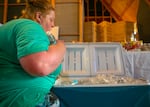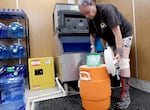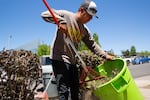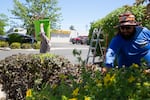People across the region have been sweltering under a heat wave that’s pushed highs into the 90s for days. Some places have even seen triple-digit temperatures.

Brendon Haggerty with the Multnomah County Health Department shows a new heat map of Portland in Portland, Ore., on April 3, 2024. “In areas where we see warmer spots, we can target those for tree planting for example, or removing some of the pavement that we have in place,” Haggerty said.
Kristian Foden-Vencil / OPB
Climate change means dangerously high heat has become more and more common in the Northwest.
OPB spoke with Oregon’s state climatologist, Larry O’Neill, who explained why extreme heat has become more common in the northwest.
The following transcript has been edited for length and clarity.
Jess Hazel: Today, Oregon is forecast to reach the peak of a heat wave that started last Thursday. Climatologists said at the start that parts of the state could see record-breaking temperatures. So has that happened?
Larry O’Neill: Well, it sure has. This has been one of the most significant heat waves in our state’s recorded history.
As of July 4th, Oregon has tied or broken about 285 high-temperature records. And this is a significant fraction of over 700 that have happened across the nation. So Oregon has really kind of been at the epicenter of this heat wave over the last week.
Hazel: And should people expect more of this extreme heat in the months to come?
O’Neill: At least for this heat wave, today will be the last day in western Oregon before it kind of breaks. Eastern Oregon will still experience some high heat over the next couple of days.
Looking forward over the next two months, at least in the next few weeks, we expect above-average temperatures. Maybe not quite like the 100 degree weather that we’ve had the last week, but it’s still going to be quite a bit warmer than normal.
Hazel: What about next year? Is dangerously high heat going to be an every-summer kind of thing from now on?
O’Neill: Yeah, over the last couple of summers it has been a consistent trend. So you may remember last summer in the 4 days in a row of over 100-degree weather. And then, of course, we also remember the 2021 heat dome event in June.
These heat waves before the 2020s, we didn’t expect them to happen more than once every 10 or 20 years. And basically the last 3 of the last 4 summers we’ve had them happen. So, this is definitely becoming more and more of a trend because of the changing climate.
Hazel: This particular stretch seems like it came pretty early in the season, too. Can you tell us more about what’s happening with the timing of these heat waves?
O’Neill: Yeah, that’s a great point. These heat waves, especially the one in 2021, happened early in the summer. When they happen early in the summer, they set the stage for a really dry summer. So we get strengthening of drought conditions and also worsening of wildfire conditions much earlier in the summer.
What happens during these heat waves is it basically just sucks all the moisture out of the ground, out of the soils and out of the trees and plants. And because we get very little rain during the summer, we’re not going to expect that moisture to come back. So it really sets the stage for high wildfire risk and also for emergence of drought conditions.
Hazel: What exactly is causing this shift toward more frequent, more intense heat, that hits earlier in the year?
O’Neill: Heat waves are a natural part of our climate system, so we’ve always had some sort of heat waves. What’s changed is that we’re getting them more frequently and they’re more intense and they’re lasting longer. And this is basically due to anthropogenic climate change.
So we’re just shifting the baseline climate to warmer temperatures. Our summers have warmed about 3 or 4 degrees Fahrenheit compared to pre-industrial conditions. And so these heat waves are just 3 or 4 degrees warmer than they used to be. Over time, we’ve found that even though it may not sound like a big temperature [change], 3 to 4 degrees, we’re seeing that the impacts are quite severe, especially to things like human health, to agriculture, and other types of systems.



























